Judah Goldfeder
AutoURDF: Unsupervised Robot Modeling from Point Cloud Frames Using Cluster Registration
Dec 07, 2024



Abstract:Robot description models are essential for simulation and control, yet their creation often requires significant manual effort. To streamline this modeling process, we introduce AutoURDF, an unsupervised approach for constructing description files for unseen robots from point cloud frames. Our method leverages a cluster-based point cloud registration model that tracks the 6-DoF transformations of point clusters. Through analyzing cluster movements, we hierarchically address the following challenges: (1) moving part segmentation, (2) body topology inference, and (3) joint parameter estimation. The complete pipeline produces robot description files that are fully compatible with existing simulators. We validate our method across a variety of robots, using both synthetic and real-world scan data. Results indicate that our approach outperforms previous methods in registration and body topology estimation accuracy, offering a scalable solution for automated robot modeling.
Robot Metabolism: Towards machines that can grow by consuming other machines
Nov 17, 2024
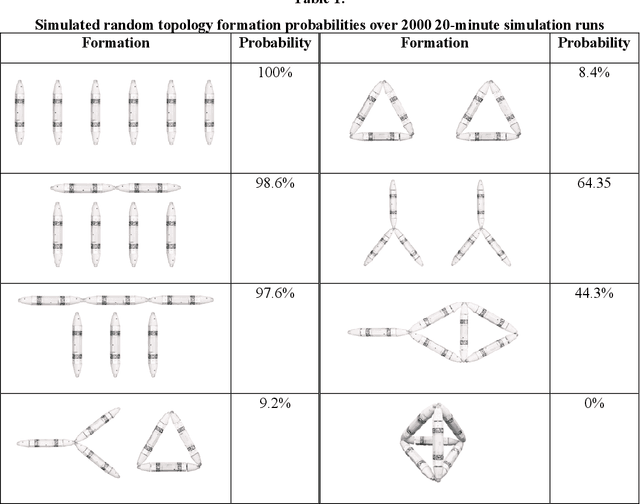
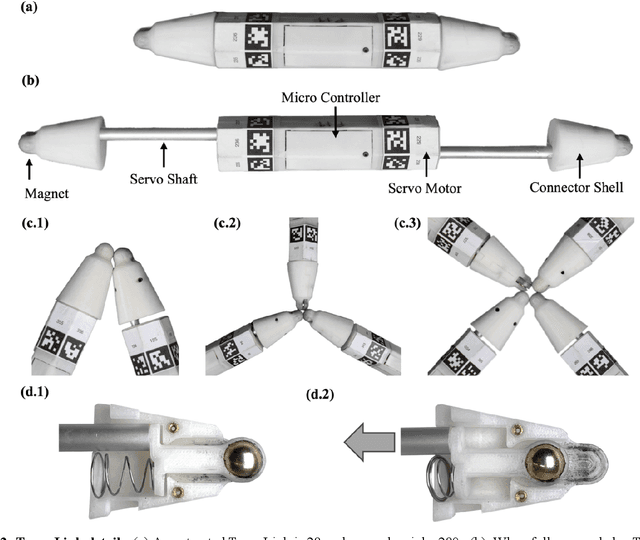
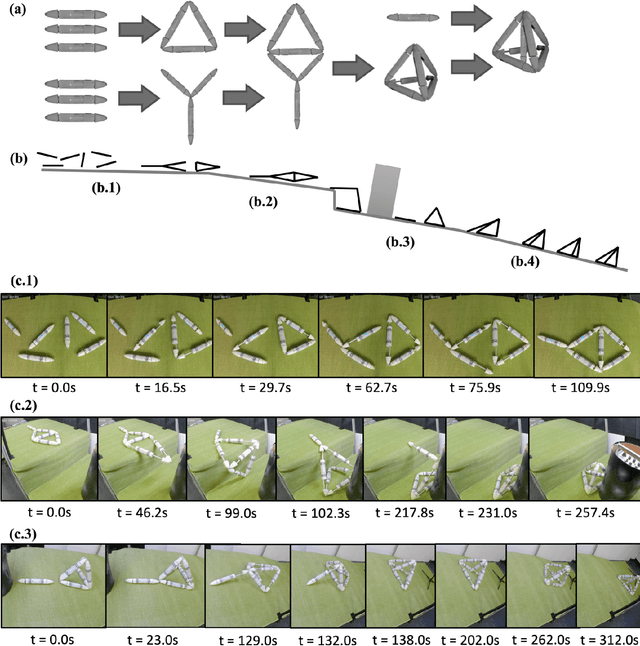
Abstract:Biological lifeforms can heal, grow, adapt, and reproduce -- abilities essential for sustained survival and development. In contrast, robots today are primarily monolithic machines with limited ability to self-repair, physically develop, or incorporate material from their environments. A key challenge to such physical adaptation has been that while robot minds are rapidly evolving new behaviors through AI, their bodies remain closed systems, unable to systematically integrate new material to grow or heal. We argue that open-ended physical adaptation is only possible when robots are designed using only a small repertoire of simple modules. This allows machines to mechanically adapt by consuming parts from other machines or their surroundings and shedding broken components. We demonstrate this principle using a truss modular robot platform composed of one-dimensional actuated bars. We show how robots in this space can grow bigger, faster, and more capable by consuming materials from their environment and from other robots. We suggest that machine metabolic processes akin to the one demonstrated here will be an essential part of any sustained future robot ecology.
Real-World Data and Calibrated Simulation Suite for Offline Training of Reinforcement Learning Agents to Optimize Energy and Emission in Buildings for Environmental Sustainability
Oct 02, 2024



Abstract:Commercial office buildings contribute 17 percent of Carbon Emissions in the US, according to the US Energy Information Administration (EIA), and improving their efficiency will reduce their environmental burden and operating cost. A major contributor of energy consumption in these buildings are the Heating, Ventilation, and Air Conditioning (HVAC) devices. HVAC devices form a complex and interconnected thermodynamic system with the building and outside weather conditions, and current setpoint control policies are not fully optimized for minimizing energy use and carbon emission. Given a suitable training environment, a Reinforcement Learning (RL) agent is able to improve upon these policies, but training such a model, especially in a way that scales to thousands of buildings, presents many practical challenges. Most existing work on applying RL to this important task either makes use of proprietary data, or focuses on expensive and proprietary simulations that may not be grounded in the real world. We present the Smart Buildings Control Suite, the first open source interactive HVAC control dataset extracted from live sensor measurements of devices in real office buildings. The dataset consists of two components: six years of real-world historical data from three buildings, for offline RL, and a lightweight interactive simulator for each of these buildings, calibrated using the historical data, for online and model-based RL. For ease of use, our RL environments are all compatible with the OpenAI gym environment standard. We also demonstrate a novel method of calibrating the simulator, as well as baseline results on training an RL agent on the simulator, predicting real-world data, and training an RL agent directly from data. We believe this benchmark will accelerate progress and collaboration on building optimization and environmental sustainability research.
Sequencing the Neurome: Towards Scalable Exact Parameter Reconstruction of Black-Box Neural Networks
Sep 27, 2024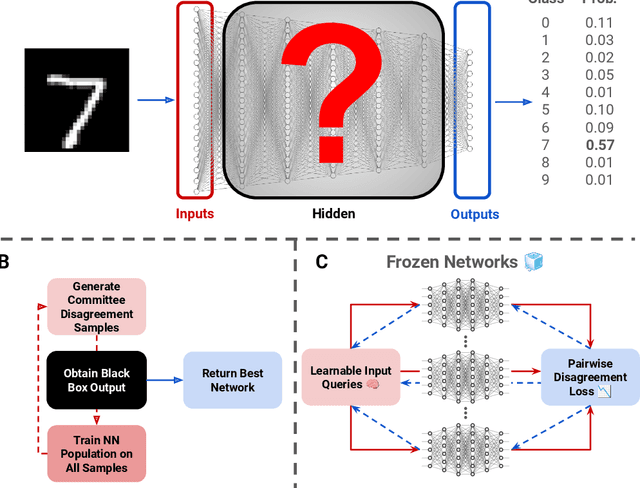

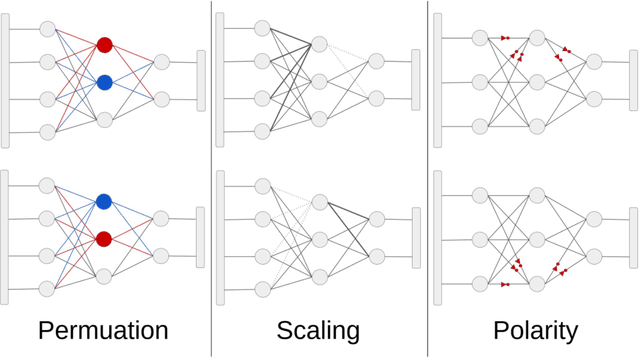
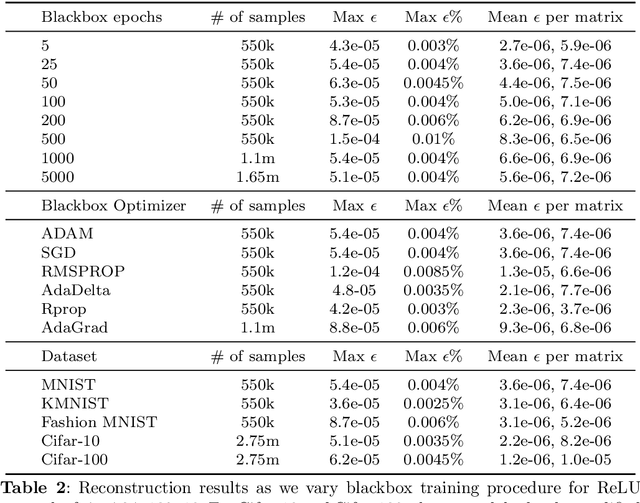
Abstract:Inferring the exact parameters of a neural network with only query access is an NP-Hard problem, with few practical existing algorithms. Solutions would have major implications for security, verification, interpretability, and understanding biological networks. The key challenges are the massive parameter space, and complex non-linear relationships between neurons. We resolve these challenges using two insights. First, we observe that almost all networks used in practice are produced by random initialization and first order optimization, an inductive bias that drastically reduces the practical parameter space. Second, we present a novel query generation algorithm that produces maximally informative samples, letting us untangle the non-linear relationships efficiently. We demonstrate reconstruction of a hidden network containing over 1.5 million parameters, and of one 7 layers deep, the largest and deepest reconstructions to date, with max parameter difference less than 0.0001, and illustrate robustness and scalability across a variety of architectures, datasets, and training procedures.
Towards End-to-End Structure Solutions from Information-Compromised Diffraction Data via Generative Deep Learning
Dec 23, 2023Abstract:The revolution in materials in the past century was built on a knowledge of the atomic arrangements and the structure-property relationship. The sine qua non for obtaining quantitative structural information is single crystal crystallography. However, increasingly we need to solve structures in cases where the information content in our input signal is significantly degraded, for example, due to orientational averaging of grains, finite size effects due to nanostructure, and mixed signals due to sample heterogeneity. Understanding the structure property relationships in such situations is, if anything, more important and insightful, yet we do not have robust approaches for accomplishing it. In principle, machine learning (ML) and deep learning (DL) are promising approaches since they augment information in the degraded input signal with prior knowledge learned from large databases of already known structures. Here we present a novel ML approach, a variational query-based multi-branch deep neural network that has the promise to be a robust but general tool to address this problem end-to-end. We demonstrate the approach on computed powder x-ray diffraction (PXRD), along with partial chemical composition information, as input. We choose as a structural representation a modified electron density we call the Cartesian mapped electron density (CMED), that straightforwardly allows our ML model to learn material structures across different chemistries, symmetries and crystal systems. When evaluated on theoretically simulated data for the cubic and trigonal crystal systems, the system achieves up to $93.4\%$ average similarity with the ground truth on unseen materials, both with known and partially-known chemical composition information, showing great promise for successful structure solution even from degraded and incomplete input data.
A Lightweight Calibrated Simulation Enabling Efficient Offline Learning for Optimal Control of Real Buildings
Oct 12, 2023Abstract:Modern commercial Heating, Ventilation, and Air Conditioning (HVAC) devices form a complex and interconnected thermodynamic system with the building and outside weather conditions, and current setpoint control policies are not fully optimized for minimizing energy use and carbon emission. Given a suitable training environment, a Reinforcement Learning (RL) model is able to improve upon these policies, but training such a model, especially in a way that scales to thousands of buildings, presents many real world challenges. We propose a novel simulation-based approach, where a customized simulator is used to train the agent for each building. Our open-source simulator (available online: https://github.com/google/sbsim) is lightweight and calibrated via telemetry from the building to reach a higher level of fidelity. On a two-story, 68,000 square foot building, with 127 devices, we were able to calibrate our simulator to have just over half a degree of drift from the real world over a six-hour interval. This approach is an important step toward having a real-world RL control system that can be scaled to many buildings, allowing for greater efficiency and resulting in reduced energy consumption and carbon emissions.
 Add to Chrome
Add to Chrome Add to Firefox
Add to Firefox Add to Edge
Add to Edge